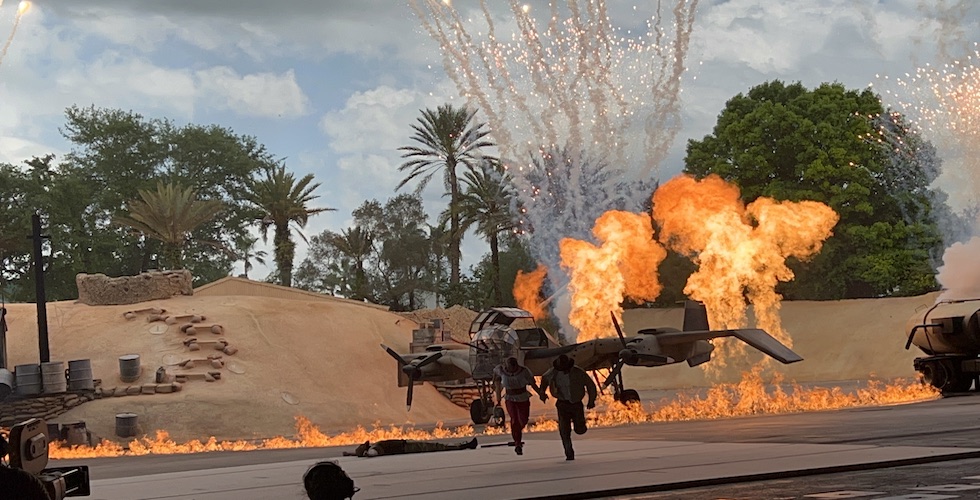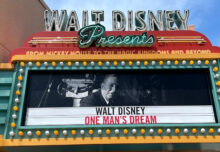Disney Attractions, both rides and shows, are adventures, and they focus on themes common to adventures: good and evil, life and death, beauty and the grotesque, fellowship, and enmity. In this blog we explore how to prepare your kids for the scary stuff at Walt Disney World.
As you sample the attractions at Walt Disney World, you transcend the spinning and bouncing of midway rides to thought-provoking and emotionally powerful entertainment. All of the endings are happy, but the adventures’ impact, given Disney’s gift for special effects, often intimidates and occasionally frightens young children.
There are rides with burning towns and ghouls popping out of their graves, all done with a sense of humor, provided you’re old enough to understand the joke.

And bones. There are bones everywhere: human bones, cattle bones, dinosaur bones, even whole skeletons. There’s a stack of skulls at the headhunter’s camp on the Jungle Cruise, a platoon of skeletons sailing ghost ships in Pirates of the Caribbean, and a haunting assemblage of skulls and skeletons in The Haunted Mansion. Skulls, skeletons, and bones punctuate Peter Pan’s Flight and Big Thunder Mountain Railroad.

At the Animal Kingdom, an entire children’s playground is made up exclusively of giant bones and skeletons.

On the other hand, the special effects at Disney’s Hollywood Studios seem more real and sinister than those in the other theme parks. If your children have difficulty coping with the ghouls of The Haunted Mansion, think twice about exposing them to Star Tours.

At Walt Disney World, anticipate the almost inevitable emotional overload of your young children. Be sensitive, alert, and prepared for practically anything, even behavior that is out of character for your child at home. Most young children take Disney’s macabre trappings in stride, and others are easily comforted by an arm around the shoulder or a squeeze of the hand. Parents who know their children tend to become upset should take it slow and easy, sampling more benign adventures, gauging reactions, and discussing with the children how they feel about what they’ve seen.
1. START SLOW AND WARM UP
Though each major theme park offers several fairly nonintimidating attractions that you can sample to determine your child’s relative sensitivity, the Magic Kingdom is probably the best testing ground. There, try Buzz Lightyear’s Space Ranger Spin in Tomorrowland, Peter Pan’s Flight or It’s a Small World in Fantasyland, and the Jungle Cruise in Adventureland to measure your child’s reaction to unfamiliar sights and sounds. If your child takes these in stride, try Pirates of the Caribbean. Try the Mad Tea Party or The Barnstormer, both in Fantasyland, or the Astro Orbiter in Tomorrowland to observe how your child tolerates certain ride speeds and motions.

Don’t assume that because an attraction is a theater presentation, it will not frighten your child. Trust us on this one. An attraction does not have to be moving to trigger unmitigated, panic-induced hysteria. Rides such as Big Thunder Mountain Railroad and Splash Mountain may look scary, but they don’t have even one-fiftieth the potential for terrorizing children as do theater attractions such as It’s Tough to be a Bug! or the animatronic octopus witch of the Under the Seas: Journey of the Little Mermaid ride.

2. BE ATTUNED TO PEER AND PARENT PRESSURE
Sometimes young children will rise above their anxiety in an effort to please parents or siblings. This doesn’t necessarily indicate a mastery of fear, much less enjoyment. If children leave a ride in apparently good shape, ask if they would like to go on it again (not necessarily now, but sometime). The response usually will indicate how much they actually enjoyed the experience. There’s a big difference between having a good time and just mustering the courage to get through.
3. ENCOURAGE AND EMPATHIZE Evaluating a child’s capacity to handle the visual and tactile
effects of Disney World requires patience, understanding, and experimentation. If a child balks at or is frightened by a ride, respond constructively. Let your children know that lots of people, adults and children, are scared by what they see and feel.
Help them understand that it’s OK if they get frightened and that their fear doesn’t lessen your love or respect. Take pains not to compound the discomfort by making a child feel inadequate; try not to undermine self-esteem, impugn courage, or ridicule. Most of all, don’t induce guilt by suggesting the child’s trepidation might be ruining the family’s fun. It’s also sometimes necessary to restrain older siblings’ taunting or teasing.
SMALL CHILD FREIGHT POTENTIAL
Of course, each youngster is different, but there are eight attraction elements that alone or combined can push a child’s buttons:
1. THE ATTRACTION’S NAME Young children will naturally be apprehensive about something called The Twilight Zone Tower of Terror.
2. THE VISUAL IMPACT FROM OUTSIDE Big Thunder Mountain Railroad looks scary enough to give even adults second thoughts, and the ride visually terrifies many young children.
3. THE VISUAL IMPACT OF THE QUEUING AREA Pirates of the Caribbean’s caves and dungeons, for instance, can frighten kids.
4. THE INTENSITY OF THE ATTRACTION Some attractions are overwhelming, inundating the senses with sights, sounds, movement, and even smell. It’s Tough to Be a Bug! at Animal Kingdom, for example, combines loud sounds, lights, smoke, animatronic insects, and 3-D cinematography to create a total sensory experience. For some preschoolers, this is two or three senses too many.
5. THE VISUAL IMPACT OF THE ATTRACTION ITSELF Sights in various attractions range from falling boulders to lurking buzzards, grazing dinosaurs, waltzing ghosts, and scary animatronics. What one child calmly absorbs may scare the bejabbers out of another.

6. THE DARK Many Disney World attractions operate indoors in the dark. For some children, darkness alone triggers fear. A child who is frightened on one dark ride (The Haunted Mansion, for example) may be unwilling to try other indoor rides.

7. THE PHYSICAL EXPERIENCE Some rides are wild enough to cause motion sickness, wrench backs, and discombobulate patrons of any age.

8. THE VOLUME The sounds in some attractions and live shows are so loud that younger children flip out, even though the general content of the presentation is quite benign. For toddlers and preschoolers especially, it’s good to have a pair of earplugs handy.

How do you
prepare your children for the scary stuff?
We receive many tips from parents telling us how they prepared their young children for the Disney experience. A common strategy is to acquaint children with the characters and stories behind the attractions by reading Disney books and watching Disney videos at home. A more direct approach is to watch videos that show the attractions.
You can also view videos at disneyplanning.com. As a YouTube supplement, it gives your kids an adequate sense of what they’ll see. You can also watch the Travel Channel’s Disney World specials streaming on Hulu, Netflix, and Disney+.
For all there is to see and do at Walt Disney World, check out The Unofficial Guide to Walt Disney World and The Unofficial Guide to Walt Disney World with Kids. If you enjoyed this post, please subscribe to our YouTube channel and sign up for our newsletter here. Follow us on Twitter, Facebook, Instagram, Pinterest, and YouTube. #theUGSeries #unofficialguide





